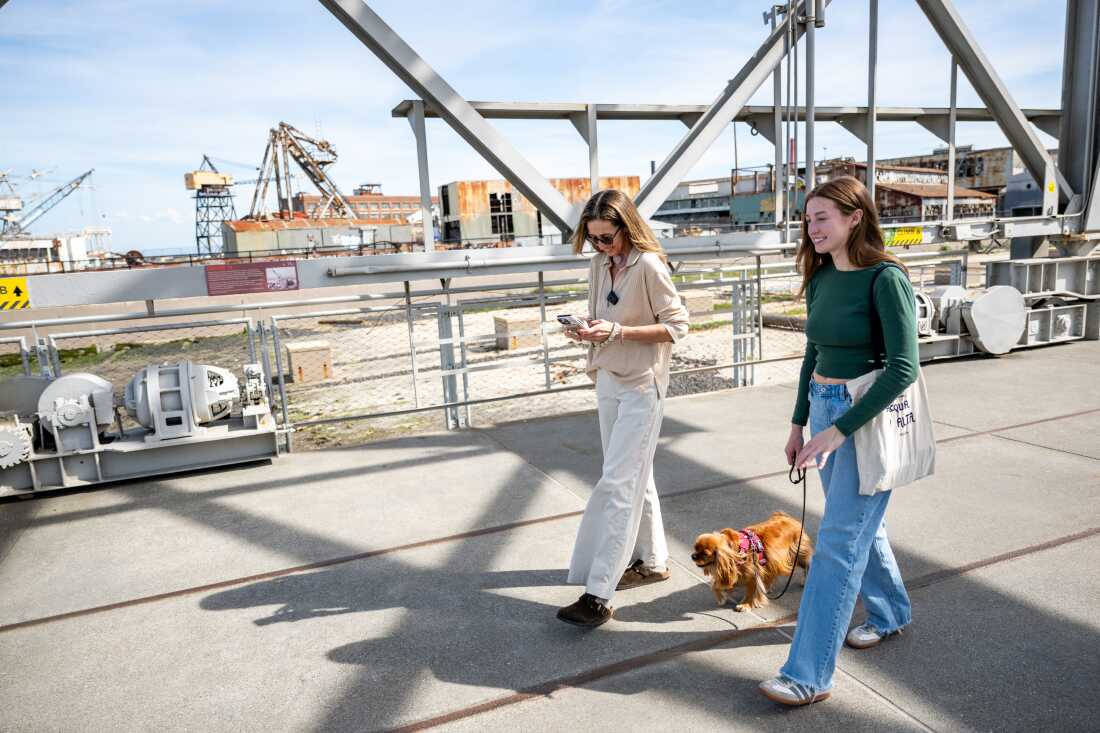Sonya Sotinksy sits at Crane Cove Park in San Francisco on March 25, 2025. Sotinsky was diagnosed with stage 4 tongue cancer and underwent surgery to remove her tongue, larynx, and other structures. She then worked with researchers to create an AI-generated voice using past recordings of her speech.
Beth LaBerge/KQED
hide caption
toggle caption
Beth LaBerge/KQED
When doctors told her they had to remove her tongue and voice box to save her life from the cancer that invaded her mouth, Sonya Sotinsky sat down with a microphone to record herself saying the things she would never again be able to say.
“Happy birthday,” and “I’m proud of you,” topped the phrases she banked for her husband and two daughters, as well as “I’ll be right with you,” intended for customers at the architecture firm she co-owns in Tucson, Arizona.
Thinking about the grandchildren she desperately hoped to see born one day, she also recorded herself reading more than a dozen children’s books, from “Eloise” to Dr. Seuss, to one day play for them at bedtime.
But one of the biggest categories of sound files she banked was a string of curse words and filthy sayings. If the voice is the primary expression of personality, sarcasm and profanity are essential to Sotinsky’s.
“When you can’t use your voice, it is very, very frustrating. Other people project what they think your personality is. I have silently screamed and screamed at there being no scream,” said Sotinsky in a recent interview, referring to rudimentary voice technology or writing notes by hand. “What the literal you-know-what?”
Fighting invasive oral cancer at age 51 forced Sotinsky to confront the existential importance of the human voice. Her unique intonation, cadence and slight New Jersey accent, she felt, were fingerprints of her identity. And she refused to be silenced.

Sonya Sotinksy uses an app on her phone to talk with her daughter, Ela Fuentevilla, at Crane Cove Park in San Francisco on March 25, 2025.
Beth LaBerge/KQED
hide caption
toggle caption
Beth LaBerge/KQED
While her doctors and insurance company saved her life, they showed little interest in saving her voice, she said. So she set out on her own to research and identify the artificial intelligence company that could. It used the recordings Sotinsky banked of her natural voice to build an exact replica now stored in an app on her phone, allowing her to type and speak once again with a full range of sentiment and sarcasm.
“She got her sass back,” said Sotinsky’s daughter, Ela Fuentevilla, 23. “When we heard her AI voice, we all cried, my sister, my dad and I. It’s crazy similar.”
‘Your voice is your identity’
It took close to a year for doctors to catch Sotinsky’s cancer. She complained to her orthodontist and dentist multiple times about jaw pain and a strange sensation under her tongue. Then water began dribbling down her chin when she drank. When the pain got so intense she could no longer speak at the end of each day, Sotinsky insisted her orthodontist take a closer look.
“A shadow cast over his face. I saw it when he leaned back,” she said, “that look you don’t want to see.”
That’s when she started recording. In the five weeks between her diagnosis and surgery to remove her entire tongue and voice box – in medical terms, a total glossectomy and laryngectomy – she banked as much of her voice as she could manage.
“Your voice is your identity,” said Dr. Sue Yom, a radiation oncologist at UC-San Francisco, where Sotinsky got treatment. “Communication is not only how we express ourselves and relate to other people, but also how we make sense of the world.”
“When the voice is no longer available, you can’t hear yourself thinking out loud, you can’t hear yourself interacting with other people,” Yom said. “It impacts how your mind works.”
People who lose their voice box, she added, are at higher risk for long-term emotional distress, depression and physical pain compared to those who retain it after cancer treatment. Close to a third lose their job and the social isolation can be profound.
Most laryngectomy patients learn to speak again with an electrolarynx, a small battery-operated box held against the throat that produces a monotonic, mechanical voice. But without a tongue to shape her words, Sotinsky knew that wouldn’t work for her.

Dr. Sue Yom, a radiation oncologist, stands with a radiotherapy system used to deliver precise, high-dose radiation treatments for cancer patients at the University of California San Francisco’s Mission Bay medical on May 16, 2025.
Beth LaBerge/KQED
hide caption
toggle caption
Beth LaBerge/KQED
When Sotinsky had her surgery in January 2022, AI voices were still in their infancy. The best technology she could find yielded a synthetic version of her voice, but it was still flat and robotic, and others strained to understand her.
She got by until mid-2024, when she read about tech companies using generative AI to replicate a person’s full range of natural inflection and emotion.
While companies can now recreate a person’s voice from snippets of old home movies or even a one-minute voicemail, 30 minutes is the sweet spot.
Sotinsky had banked hours in her children’s book readings.
“Eloise saved my voice,” Sotinsky said.
Now she types what she wants to say into a text-to-speech app on her phone, called Whisper, which translates and broadcasts her AI voice through portable speakers.

Sonya Sotinksy often uses a portable keyboard to talk using the text-to-speech software on her phone.
Beth LaBerge/KQED
hide caption
toggle caption
Beth LaBerge/KQED
Most doctors and speech therapists who work with head and neck cancer patients don’t realize AI software can be used this way, Yom said, and with their focus on saving lives they often don’t have the bandwidth to encourage patients to record their voices before they lose them in surgery.
Health insurance companies likewise prioritize treatments that extend life over those that improve its quality — and typically avoid covering new technologies until data proves their actuarial value.
Sotinsky and her daughter spent months wrangling with claims adjusters at Blue Cross Blue Shield of Arizona, but the insurer refused to reimburse Sotinsky for the $3,000 she spent on her initial assistive speaking technology.
“Apparently, having a voice is not considered a medical necessity,” Sotinsky quipped, her AI voice edged with sarcasm.
Sotinsky now pays the $99 monthly fee for her AI voice clone out of pocket.
“While health plans cover both routine and life-saving care, assistive communication devices are typically not covered,” said Teresa Joseph, a spokesperson for Blue Cross Blue Shield of Arizona. “As AI provides opportunities to impact health, we imagine that coverage criteria will evolve nationally.”
How research might lead to insurance coverage
Sotinsky resolved to use her newfound voice to help others regain theirs. She stepped back from her work in architecture and built two websites detailing her voice banking journey — voicebanknow.com and glossectomygirl.com. She tells her story at conferences and webinars, including an oncology conference in Denver that Yom organized for 80 scientists.
One doctor who attended, Jennifer De Los Santos, was so inspired by hearing Sotinsky’s voice that she began laying the groundwork for a clinical trial on the impact AI technology has on patients’ communication and quality of life. That type of research could generate the data health insurers need to measure actuarial value.
“And therefore justify coverage by insurance,” said De Los Santos, a head and neck cancer researcher and professor at Washington University in St. Louis.
Breast cancer survivors faced a similar battle in the 1980s and 90s, she added. Insurers initially refused to cover the cost of breast reconstruction after a mastectomy, calling the procedure cosmetic and unnecessary.
It took years of patient advocacy and carefully crafted data showing reconstruction had a profound impact on women’s physical and emotional well-being before the federal government mandated insurance coverage in 1998.
Both De Los Santos and Yom said research data on AI voice clones will likely follow a similar path, eventually proving that a fully functioning, natural-sounding voice can lead to not only a better life, but a longer one.

Sonya Sotinksy has built two websites detailing her experience in voice banking, and tells her story at conferences, including an oncology conference in Denver for 80 scientists.
Beth LaBerge/KQED
hide caption
toggle caption
Beth LaBerge/KQED
In recent months, Sotinsky’s AI voice literally helped save her life. Her cancer had resurged in her lungs and liver. Her voice allowed her to communicate with her doctors and participate fully in developing the treatment plan. It showed her just how “medically necessary” having a voice is.
She noticed that doctors and nurses took her more seriously. They didn’t tune out the way people often did when she relied on her more robotic, synthesized voice. It seemed they saw her as more fully human.
“If someone can only communicate using a few words at a time, and not elaborate and interface more fully, it’s natural that you can’t detect that they have more depth of thought,” she said. “Being able to dialogue with my care team in a more seamless way is vital.”
While doctors successfully treated her latest round of cancer, Sotinsky, now 55, said she is confronting her odds in a new way, facing the reality that she will likely die much sooner than she wants.
All over again, she realized how crucial her voice is for maintaining perspective on life and a sense of humor in the face of death.
“I tend to forget and think I am fine, when in reality, this is forever now. Emotionally, you start to get cocky again and this was like, ‘Whoa, b****, we ain’t playing.’ This cancer is real,” Sotinsky said, typing her next phrase with a mischievous grin.
“Sarcasm is part of my love language.”
This story comes from ReadNOW’s health reporting partnership with KQED and KFF Health News.